Regional employment patterns in Scotland: statistics from the Annual Population Survey 2018
Summary publication of results from the Annual Population Survey 2018, presenting analysis on the labour market, education and training.
This document is part of a collection
Section 4: Skills
4.1 Skills of Population
National Performance Framework Indicator
Skill profile of the population
11.6 per cent (387,400) of the population in Scotland aged 16-64 years old have low or no qualifications (SCQF level 4 or below).
The proportion of the population with low (SCQF level 4 or below) or no qualifications has decreased from 16.3 per cent in 2008 to 11.6 per cent in 2018*. However, the proportion has increased over the year from 10.8 per cent in 2017*.
Chart 23: Percentage of population (16-64) with low or no qualifications, 2004-2018, Scotland
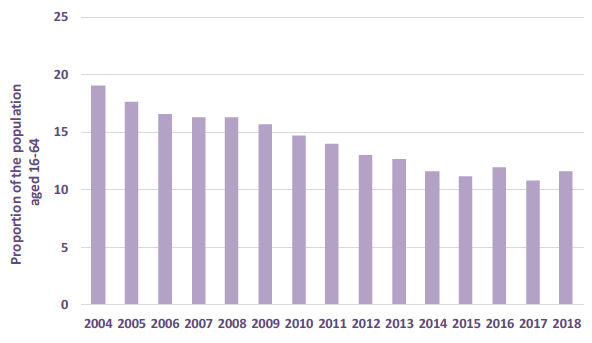
There is regional variation across Scotland in the proportion of the population with low or no qualifications.
North Lanarkshire (18.1 per cent), West Dunbartonshire (16.7 per cent) and Glasgow City (16.6 per cent) had the highest proportion of people aged 16-64 years old with low or no qualifications, while East Dunbartonshire (5.9 per cent), East Renfrewshire (6.5 per cent) and Edinburgh (6.7 per cent) had the lowest proportion of people aged 16-64 years old with low or no qualifications.
Since 2008, the proportion of the population with low or no qualifications has decreased in all local authorities across Scotland.
The largest decreases were seen in Clackmannanshire down by 10.8 percentage points to 12.9 per cent*; Dumfries and Galloway down by 8.2 percentage points to 10.9 per cent* and Renfrewshire down by 7.4 percentage points to 11.5 per cent*.
Since 2017, the proportion of the population with low or no qualifications has increased in 19 local authorities, decreased in 9 local authorities and remained the same for one local authority across Scotland (none of which were statistically significant changes).
Note: data not available for Na h-Eileanan Siar, Orkney Islands and 28 Shetland Islands
4.2 Workforce skills
Scotland has a highly qualified workforce. 48.9 per cent of workers aged 16-64 years in Scotland have further or higher education (HE/FE) qualifications (SCQF level 7+). This compared with 38.2 per cent in 2008 and is higher than the 2018 UK rate of 44.3 per cent.
Compared with 2008, the number of workers who have SCQF level 7+ qualifications has increased by 31.5 per cent from 948,400 to 1,247,700 in 2018.
Chart 24: Percentage of workers (16-64) by level of qualification held 2004-2018, Scotland
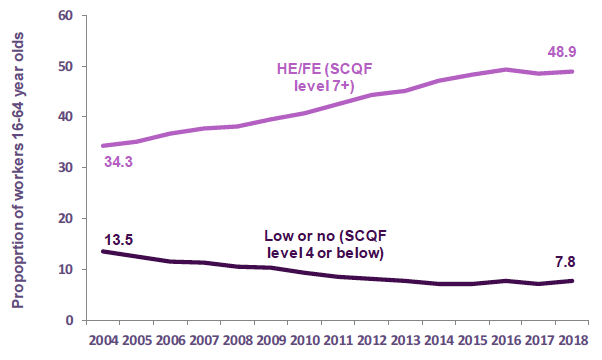
In 2018, the employment rate for those aged 16-64 years with further or higher education qualifications (SCQF level 7+) was higher than for those with low or no qualifications (82.3 per cent and 51.0 per cent, respectively).
Although the employment rate for those with SCQF level 7 and above has decreased from 85.0 per cent in 2008 to 82.3 per cent in 2018, the gap in the employment rate for those with higher or further education, compared with those with low or no qualifications has decreased from 37.2 percentage points in 2008 to 31.3 percentage points in 2018.
Figure 7: Employment rate (16-64) by qualification level, 2018
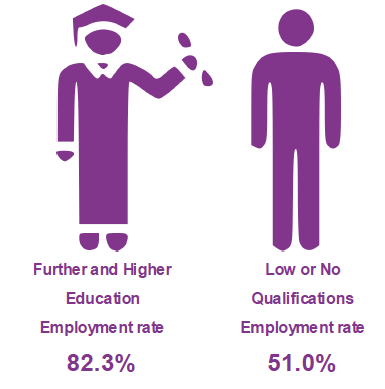
4.3 Occupational Skills
Between 2004 and 2018, there has been a large increase in high skilled occupations (e.g. functional management in finance, marketing, public finance, etc.) and medium-high skill occupations (e.g. health associate professional or nurse), compared with a decline in low skill (e.g. bar staff, cleaning) and medium low skill occupations (e.g. sales assistant, retail cashier). However, employment in each of the occupational skills levels has remained relatively constant over the last year.
Employment in higher skilled occupations increased by 29.7 per cent between 2004 and 2018, increasing from 536,800 to 696,000. Medium-high skilled occupations increased by 10.5 per cent from 657,000 to 726,200. These two categories account for 54.1 per cent of all jobs in 2018. Medium-low skilled and Low skilled occupations decreased over the same period, by 2.4 per cent and 0.8 per cent respectively.
Chart 25: Cumulative increase in occupation skills level of employment (16+) since 2004, Scotland
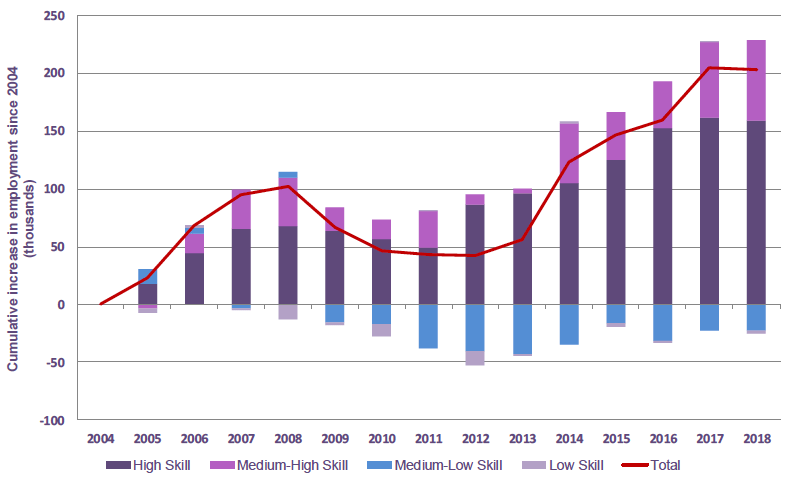
4.4 Graduates
Chart 26: Percentage of workers (25-64 years) who are graduates, 2004-2018, Scotland
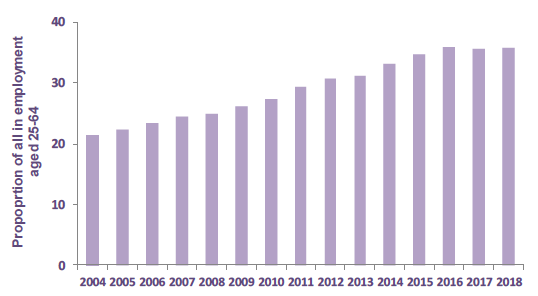
35.8 per cent (772,300) of workers in Scotland aged 25-64 years old in 2018 were graduates (SCQF level 9+), close to the highest on record (35.9 per cent in 2016).
The proportion of workers aged 25-64 years old who are graduates has increased from less than a quarter (24.8 per cent) in 2008 to 35.8 per cent in 2018* and has increased slightly over the year from 35.6 per cent in 2017.
However, there is large regional variation across the country.
Almost 60 per cent of workers in Edinburgh were graduates, compared with around 1 in 5 workers in North Lanarkshire.
Table 2: Percentage of workers (25-64 years) who are graduates by local authority, 2018
| Percentage of workers aged 25-64 years | |||
|---|---|---|---|
| Highest | % | Lowest | % |
| Edinburgh | 59.9 | North Lanarkshire | 21.4 |
| East Renfrewshire | 51.2 | Moray | 22.8 |
| East Dunbartonshire | 48.9 | Inverclyde | 22.9 |
4.5 Job Related Training
National Performance Framework Indicator
Work place learning
The percentage of employees who reported receiving job related training in the last 3 months has been decreasing over time. In 2004, around one third of workers (31.2 per cent) received job related training in the last 3 months, decreasing to 22.5 per cent in 2018*.
Chart 27: Percentage of employees (16-64) who received job related training in the last 3 months, 2004-2018, Scotland
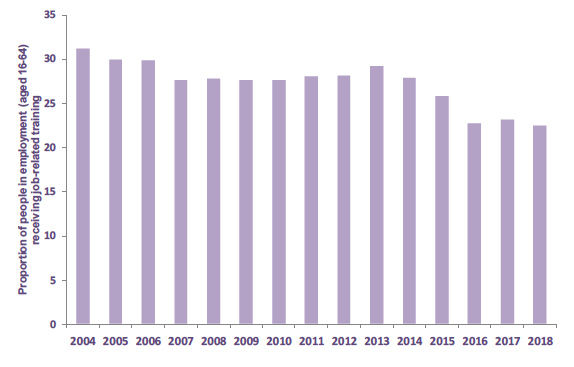
South Ayrshire (31.2 per cent), Na h-Eileanan Siar (30.5 per cent) and Inverclyde (29.4 per cent) had the highest proportion of employees aged 16-64 years old who reported receiving job related training, while Renfrewshire (17.5 per cent), West Dunbartonshire (18.0 per cent) and South Lanarkshire (18.5 per cent) had the lowest proportion of employees aged 16-64 years old who reported receiving job related training.
Since 2008, the proportion of employees aged 16-64 years old who reported receiving job related training has decreased from 27.8 per cent to 22.5 per cent in 2018*.
Across Scotland, the largest decreases were seen in East Dunbartonshire down by 15.2 percentage points to 19.5 per cent*; West Dunbartonshire down by 14.2 percentage points to 18.0 per cent* and Moray down by 13.3 percentage points to 18.8 per cent*.
Since 2017, the proportion of employees aged 16-64 years old who reported receiving job related training has decreased from 23.1 per cent to 22.5 per cent in 2018.
Across Scotland, the largest decreases were seen in West Dunbartonshire down by 11.0 percentage points to 18.0 per cent*; East Dunbartonshire down by 9.3 percentage points to 19.5 per cent* and Renfrewshire down by 9.2 percentage points to 17.5 per cent*.
* Statistically significant
Contact
If you have any enquiries relating to Labour Market Statistics then please contact us at:
Email: LMStats@gov.scot
Telephone: 0131 244 6773
Fax: 0300 244 1060
Post:
Labour Market Statistics
OCEAES: Economic Strategy and Policy
Scottish Government
5th Floor
5 Atlantic Quay
150 Broomielaw
Glasgow
G2 8LU
We welcome any comments on both the format and content of the website, including any problems you may encounter.
You may also contact the Statistician Group Enquiries for general information.
There is a problem
Thanks for your feedback